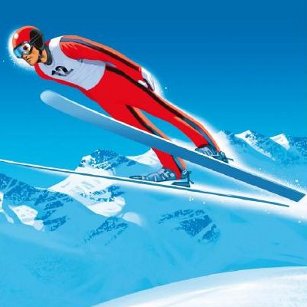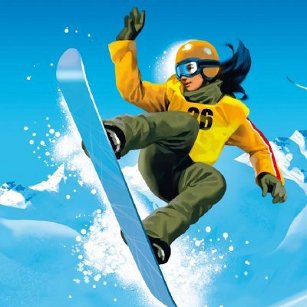20.01.2010
r.
5 Euro,
Winter Games 2010:
Ski-jump, 2010

Skoki narciarskie to
dyscyplina sportowa rozgrywana na skoczniach
narciarskich od połowy XIX wieku. Od 1924 roku skoki mężczyzn są
konkurencją olimpijską na normalnej skoczni, od 1964 także na dużej;
Mistrzostwa Świata od 1925 na normalnej, od 1962 na dużej; od 1972
także Mistrzostwa Świata w lotach; od 1953 roku prestiżowy Turniej
Czterech Skoczni, a od 1980 cykl zawodów składających się na
Puchar Świata. Rozgrywane są również mistrzostwa świata
juniorów. W 1997 roku dołączył także Turniej Nordycki.
Najbardziej prestiżowe zawody kobiet to Puchar Kontynentalny. Wchłonął
on w 2004 dotychczasowy najważniejszy cykl kobiecy, FIS Ladies Grand
Prix, rozgrywany od 1999, początkowo pod nazwą FIS Ladies Grand
Tournée. Od 2009 skoki kobiet wejdą w program Mistrzostw
Świata, a od 2014 w program Igrzysk Olimpijskich.
Celem jest wykonanie jak najdłuższego skoku po rozpędzeniu się i
odbiciu od progu skoczni. Na największych skoczniach, tzw. mamucich,
możliwe są skoki przekraczające 200 metrów (konkurencję tę
nazywa się wtedy lotami narciarskimi). Ocenia się odległość uzyskaną
przez zawodnika oraz styl skoku.
Skoki narciarskie są dyscypliną elitarną, właściwie niedostępną dla
amatorów. W wielu krajach (m.in. Finlandia, Norwegia,
Niemcy, Austria, Japonia, ostatnio również Polska) bardzo
popularne jest kibicowanie skoczkom.
Obecnym rekordzistą świata jest Norweg Bjørn Einar
Romøren. Uzyskał on odległość 239 m na największej skoczni
na świecie, skoczni mamuciej w Planicy.
Winter Games 2010 - 5 Euro-coin
- ski jumper - snow-boarder
Date
of issue: January 20th, 2010, mintage: 50,000 sets of both coins,
quality: special uncirculated, Fine weight: 8 g., diameter: 28,5 mm,
fineness: Ag 800/1000
In Austria skiing is the King of Sports.
Every winter not only Austrians but thousands upon thousands of skiing
enthusiasts from other countries flock to the snow covered slopes of
the Austrian Alps.
It is not surprising that Austria, like
neighbouring Switzerland and the Nordic Countries, always does well at
winter games and tournaments, no matter where they are held. That, of
course, holds particularly true for the Winter Olympics, this year to
be held from 12th to 28th February in and around Vancouver on the west
coast of Canada's British Columbia.
To celebrate the Winter
Games, the Austrian Mint in Vienna is issuing two silver 5 Euro coins
on 20th January, 2010. Each displays a winter discipline in which
Austria is a world-leading performer.
The first has as its
theme ski jumping. One sees the helmeted ski-jumper captured in his
flight from the end of the steep ramp against a background of trees in
an alpine forest.
The second design shows a female
snow-boarder as she performs a hair-raising air trick, flipping her
snowboard up over the rim of the half-pipe in which they perform.
The
ski jumper was designed by Helmut Andexlinger, while the female
snow-boarder is the work of chief engraver, Thomas Pesendorfer. Both
coins share common design features and are characterised by dramatic
movement. The official side of the nine-sided coins is the standard
ring of the shields of the nine federal provinces of the Republic of
Austria with the face value "5" in the centre.
źródło: Austrian
Mint /
Wikipedia












